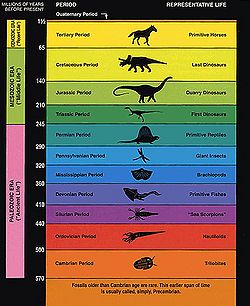Fossils: The Biblical View
| Student files |
 The fossil
record is a "recording" of history made out of
layers of fossils. Much like the growth
rings in a tree or the layers found in ice
cores, the earth is covered in layers (strata)
of sedimentary
rock which represent a sequence of events. More
specifically this strata records the relative times when the
fossilized organisms were buried by sediment. In contrast to many
records of human history, however, layers of the "fossil record"
come without universally recognized methods of dating.
The fossil
record is a "recording" of history made out of
layers of fossils. Much like the growth
rings in a tree or the layers found in ice
cores, the earth is covered in layers (strata)
of sedimentary
rock which represent a sequence of events. More
specifically this strata records the relative times when the
fossilized organisms were buried by sediment. In contrast to many
records of human history, however, layers of the "fossil record"
come without universally recognized methods of dating.
Evolutionists hold that this record represents a history of life on Earth over hundreds of millions of years, and fossils are offered as the main evidence to support the theory that organisms have evolved from simple to more complex forms. However, most creationists believe that the vast majority of the fossils are instead the remains of plant and animals that died during the Biblical global flood. Some creationists prefer to use a phrase like "fossil layers" to avoid the connotation that it offers evidence for the macroevolution of living forms over millions of years.
Fossils
- Main Article: Fossils
Fossils are remnants or traces of organisms from the past, that are typically embedded and preserved in sedimentary rock. There are three types of fossils: imprints, casts, mineralization.
- Imprints are where the organism simply left an imprint on a rock.
- Casts are where the organism left a cavity in a rock that got filled in by other material.
- Mineralization is where the material of the bones or other body parts get replaced by minerals.
Layers of fossiliferous rocks provide a record of the sequence of their deposition. This "fossil record" is typically diagrammed in a cross-section known as the geological column.
Today fossilization is an extremely rare event and is simply not expected to occur on a global scale. Decomposition is instead the rule following death, unless the matter is buried rapidly and to a depth that would prevent microbial digestion and oxidation. Hard shelled animals that burrow into sediment are somewhat expected to be found as fossils, along with large and heavy bones through random circumstances. However, every kind of animal alive today is found in the fossil record. Many of these are completely intact, and some specimens show literally no signs of decomposition. Other evidence such as polystrate fossils, or the fact that marine fossils are found throughout the geological column, points strongly to a flood-based interpretation of the fossil record. It should also be noted that many of the animals alive today are virtually identical to their fossilized ancestors, which argues strongly against their having been fossilized millions of years ago.
Geological Column
- Main Article: Geological Column
The geological column is a theoretical classification system for the rocks and fossils that make up the Earth's crust. It was devised based on the interpretation that layers of sedimentary rock formed over millions and even billions of years at uniform geologic rates.
Almost all fossils on earth are found buried in layers of sedimentary rock called strata. These layers are characterized as horizontally indefinite or laterally continuous. They can often be traced across the entire continents, and correlated with layers in other countries. Many of these rock layers have been given names and are frequently diagrammed as a cross-section known as the geologic column.
It is often depicted as sequences of fossil layers known as strata, with the simplest fossils on the bottom and more complex ones on top. It is divided into several geologic periods, based on the fossils found in them. The geologic column was assembled by comparing fossils from various locations, however, it is extremely rare for all of these layers be found at any one location. In reality the geologic column is nothing but a mental abstraction.
Fossil Sorting
- Main Article: Fossil sorting
Fossil sorting is an observable characteristic of the fossil record wherein organisms present during the antediluvian period are commonly found only within a limited span of strata (layers of rock), and frequently above or below other specific fossils. Young earth creationists assert that fossiliferous rock is almost entirely the result of the Biblical flood described in Genesis 6-9, and the sorting explained by flood geologists as the result of several factors present during the flood, including ecological zonation, hydrological sorting and liquefaction, differential escape, biogeographic zonation, and tectonic activity.
In contrast, Uniformitarian geologists assert that the fossil record formed over hundreds of millions of years (geologic ages) and is a recording of the evolutionary history of life on earth with primitive organisms being buried first and thus deeper in the rock strata. During the 19th century, fossil sorting and the uniformitarian interpretation became a point of departure for many creationists who found the Biblical global flood unable to explain this observation. Today any old earth creationists accept the fossil record as proof of evolution over millions of years.
Philosophical interpretation
Jonathan Sarfati summarizes the difference between the evoluion and creation points of view.
| “ | Creationists and evolutionists interpret the geological layers differently because of our different axioms. Evolutionists interpret the sequence of layers as a sequence of ages with different types of creatures; creationists interpret them as a sequence of burial by a global flood and its after-effects. This makes better sense of phenomena such as ‘living fossils’ and finding creatures such as the coelacanth, which isn’t found in rocks ‘dated’ younger than 70 million years.[1] | ” |
Uniformitarianism
- Main Article: Uniformitarianism
Uniformitarianism is a guiding principle of origins science that says that the same processes that operate on the universe now, have always operated on the universe in the past, and at the same rates; and that the same laws of physics apply everywhere in the universe. A uniformitarian is one who believes in the principles, or any number of aspects and/or assumptions of the philosophy of uniformitarianism.
Uniformitarianism is an important element within modern Geology as it is practiced by evolutionists and embraces the idea of deep time and an old earth. Less well appreciated is its importance as an element in astronomy, in that it also assumes deep time and even infinitely deep time for the entire universe. Uniformitarianism is based on the philosophy of naturalism and was promoted in James Hutton's book "Theory of the Earth" and later expanded upon by Charles Lyell in his three-volume series "Principles of Geology" first published 1830-1833. Charles Darwin took Lyell's books on board the ship HMS Beagle. During that voyage, Lyell's works informed Darwin's thinking about slow biological change known as gradualism.
Catastrophism
- Main Article: Catastrophism
Catastrophism is the assumption that entire strata systems, and even groups of systems, were accumulated in a hydraulic cataclysm matching the description of sudden catastrophic events. The secular interpretation of earth's history assumes there were repeated floods and other catastrophes which caused the extinction of many animals, but were of insufficient intensity to destroy all terrestrial life. However, the Bible says there was a flood that no terrestrial animal or human could survive without divine intervention. And indeed, a single event capable of depositing the entire geological column would not be survivable. It is certainly a fact that cataclysms have occurred in the earth's past, and vast layers of sediment testify to these disasters. When you examine the evidence closely you will see that the fossil record has simply been misinterpreted by the atheistic scientific community, and is instead a recording of a devastating global flood.
Fossils
References
- ↑ Sarfati, Jonathan. Refuting Evolution 2 Chapter 8 - Argument: The fossil record supports evolution. Greenforest AR: Master Books, 2002. (p148)
Additional Reading
- Anomalously Occurring Fossils
- Living Fossils
- Fossil Sorting
- Dinosaur Fossils
- Human Fossils
- Fossils on the CreationWiki
The Witness of Fossils: Evolution or the
Flood?
| Student files | Teacher files |



